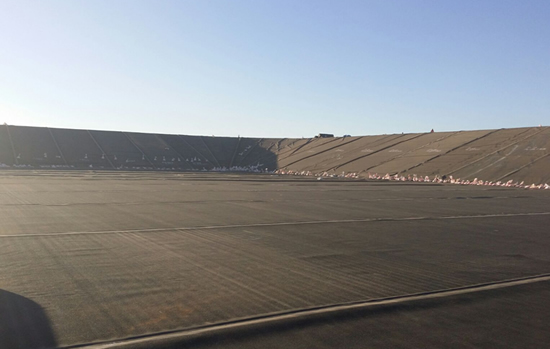By Catrin Tarnowski – Geomembrane wrinkling occurs, but it can be minimized. “Lay flat” geomembrane installations are quite possible, as they are documented all over the world. Truly, we can achieve this; yet, geomembrane wrinkling still happens.
How does wrinkling occur? It is connected to numerous decisions made in design, product selection, and installation procedures, and with boundary conditions on site. So how can we improve the total global practice?
Some important considerations and best practices are summarized here.

GEOMEMBRANE WRINKLING – MANAGING THERMAL EXPANSION
During installation, geomembranes will inevitably be exposed. (Indeed, the facility itself may be designed for a longer period of exposure or partial exposure as the geomembrane’s service life begins.) As the liner sits in the open air, it may build up heat due to UV exposure or general rising temperatures in the environment at the job site. Thermal elongation can occur, no matter where the installation happens: Germany, Burkina Faso, Japan, South Africa, etc.
Thermal elongation is a reversible effect and can be controlled. The question that must be answered is how to design with additional slack or to design with anchoring and ballasting.
Some important points to remember:
- Waviness and dimensional stability must be considered together. The more “frozen” tension is in the product, the higher the variance in dimensional stability—developing waves when temperature changes occur. If the dimensional stability is controlled, liners stay flat or waves which occur can again disappear.
- Thermal expansion and contraction behavior, as well as stress relaxation, must be considered from design to operation
- Uncovered slopes are the most critical to monitor
- If geomembrane wrinkling or bridging does occur as a result of thermal expansion (or due to environment, wind uplift, cover placement, etc.), great care must be applied to any extra extrusion welds that are made.
- Lighter surface colors on a geomembrane, such as white geomembranes, reduce geomembrane wrinkling from thermal expansion.
- Waves that develop in a textured geomembrane have a higher tendency to remain than waves in a smooth liner
- Thickness has no real effect on wrinkling

In general, good practice can avoid the need to cut material or engage in additional welding. Experienced designers and installers are recommended.
RELATED: Essential Questions Series – Geomembrane Wrinkles and Bridging
GEOMEMBRANE INSTALLATION
Best practices in installation are vital to getting a geomembrane into service in as ideal condition as possible. This again underscores the importance of experienced geosynthetic installers.
Some considerations:
- When welding together geomembrane panels, the panels should have the same temperature to avoid wrinkling. Thus, a panel just unrolled should not immediately be welded to one that was installed the prior day or one which has been heating up for a while already. When panels of like temperature are welded—when the installer observes this proper sequencing—one can avoid the development of diagonal waves and waves in the weld area.
- Geomembrane rolls should be stored on a level surface and one must keep in mind how the site’s environment may apply temperature effects to the rolls before they are even unrolled.
- Weld panels when they are flat
GEOMEMBRANE ANCHORING & BALLASTING
Large liner areas are sometimes built with insufficient anchor design. If those areas are left uncovered, geomembrane wrinkling and bridging can occur, due to wind uplift or temperature changes and the resulting movement they cause in the liner.
We can perhaps learn more from the many successful installations with very large liner areas, such as large dam lining projects or pumped storage ponds. In those applications, it is not uncommon to find the design incorporating intermediate anchoring to keep the whole lining system flat.
In regards to ballasting of a liner on site, we should as a field ask: Is ballasting an issue that we leave for the geomembrane installer to make decisions on? Or, can we actually specify particular methods for keeping a geomembrane flat? For example, the anchor bar method (Riegelbauweise) is one approach that has been used to keep a geomembrane flat during installation.
There are a variety of measures to keep liners flat, and specifying them does not necessarily have to impact installation progress (e.g., force the installation to take longer). Why not better utilize these approaches?
IMPORTANCE OF TEAM WORK
It must be stressed that to prevent geomembrane wrinkling, bridging, and voids, we must actively recognize the need to be part of a team. The designer, the installer, the CQA professional, and all other stakeholders in a project can and do influence the facility’s success—and that includes down to whether wrinkles develop in the system.
Experience and communication are essential.
**
Catrin Tarnowski works for Solmax, www.solmax.com.












This article by Catrin was very good.